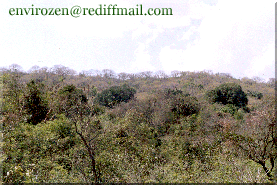  |
|
|
|
|
|
|
|
|
|
||||||
| [ Home ] | [ Study Area ] | [ Forest Types ] | [ References ] | [ The Team ] | [ Contact ] | [ Links ] |
|
|
||||||
  |
|
|
|
|
|
|
|
|
|
||||||
| [ Home ] | [ Study Area ] | [ Forest Types ] | [ References ] | [ The Team ] | [ Contact ] | [ Links ] |
|
|
||||||
|
Forest types The forests of Jammu district have been divided into three types in accordance with the classification made in revised survey of forest types of India by Champion and Seth (1968). These include :- A) A) Type 5B/C2 - Northern Dry Mixed Deciduous Forests It occupies an area of 804.46 km2 of Jammu district which accounts to 27.3% of its total geographical area. On satellite imagery, this forest type appears as bright red tone with smooth texture. This forest type is confined to Jammu foothills of low to moderate elevations. The dense forest, sometimes interrupted by scrubby vegetation is predominantly found in Ramnagar and Nandani wildlife sanctuaries and along the shady depressions. The soils are well drained and have sandy loam to clay loam texture with normal pH varying from 7.5 to 8.8. The nitrogen and phosphorous status is low and potassium high. Noteworthy feature of this forest type is its transition from semi deciduous tropical type to subtropical chirpine zone, occurring on tops and higher slopes of these hills. The area is considered richest during monsoon and post-monsoon period with great diversity among epiphytic and herbaceous flora.
Among arboreal elements
Mallotus phillipensis Muell.-Arg. tend to become gregarious in certain
depressions along seasonal streams and is mainly found associated with
Cassia fistula L. especially in Kalidhar range. Grewia optiva J.R.
Drum, Dalbergia sissoo Roxb., Toona cilliata Roem.,
Flacourtia indica Merr., Ficus palmata Forsk., Lannea
coromendalica Merr., Crataeva adansonii DC, Mangifera indica
L., Melia azedarach L., Syzigium cumini Skeels, Aegle
marmelos Willd., Bombax cieba L., Albizia lebbeck Benth.,
Phyllanthus emblica L., Ougenia oogeinensis Hochr.,
Bauhinia variegata L., Mitragyna parviflora Korth. constituted a
rich assembly of species. |
|
 |
Xylosoma longifolium Clos., Terminalia chebula Retz., Oroxylum indicum Vent., Bridelia verucosa Haines, Ficus auriculata Lour., F. racemosa L., Wendlandia heynei Sant. & Merch., Elaeodendron roxburghii and Gmelina arborea Roxb. occur as isolated individuals or in groups of few. Comparatively more exposed along the northeastern and northern slopes is vegetation characteristic of thorn scrub. Noteworthy in this aspect are Acacia modesta Wall., Flacourtia indica Merr., Zizyphus mauritiana Lamk., Mimosa rubicalis Lamk. and Carissa opaca L., found associated with nonthorny elements viz., Lannea coromandelica Merr., Dodonaea viscosa Jacq. and Adhatoda vesica Nees. |
|
Among shrubs, Dodonaea viscosa Jacq. is the conspicuous shrub, occurring almost in pure formations and covering large areas of ground in certain places. Isolated thickets of Carissa opaca L.and patches of Adhatoda vasica Nees. are other components interspersed in Dodonaea scrub. Woodfordia fruticosa Kurz., Coolebrookia oppositifolia Sm., Capparis sepiaria L., Abutilon indicum Sw., Nerium indicum Mill., Punica granatum L. are found strikingly abundant and frequently associating. Woodfordia fructicosa Kurz., Colebrookia oppositifolia Sm., and Nerium indicum Mill. occur in greater number in riparian localities. Limited in number and restricted to shady and cooler habitats on southwestern slopes are shrubby components, which include Reinwardtia indica Dumort., Antidesma diandrum Roth., Eranthemum pluchellum Andr. etc. Along the sides of ravines, Phanera vahlii Benth., a conspicuous liana, which climbs high, mostly on tops of nearby broadleaved trees and sometimes even up to the height of 20 meters, on chirpine trees. Other climbers, typical of these hills and slopes are Hiptage benghalensis Kurz., Shutteria densiflora Benth., Clematis gouriana Roxb., Helinus lanceolatus Brandis., Pueraria tuberosa DC., Porana paniculata Roxb., Argyeria thomsonii Craib., Dregea volubilis Benth. ex. Hk. F., Cissampelos pariera L., Atylosia crassa Prain. and Tylophora hirsuta W & A. Only two specimens of Caesalpinia decapatela Alston - a straggling liana were seen in the forest. Majority of these climbers are restricted to cool and shady habitations along the southwestern slopes. The herbaceous layer is structurally and numerically most prominent during monsoon season. Most commonly found species include Anagalis arvensis L., Fumaria indica Pugsley, Oxalis corniculata L., Stellaria media Vill., Gnaphalium purpureum L., Eclipta prostrata L., Youngia japonica DC, Salvia plebia R. Br., Malvastrum coromendellianum Garcke, Erigeron bonariensis L., Bidens biternata Merr. and Sherff., Achyranthes aspera L., Sonchus oleraceus L., Euphorbia hirta, Geranium rotundifolium L., Carex fedia Nees., Cynodon dactylon Pers. etc. Most of understorey is dominated by scattered or gregarious chunks of weed flora. The commonly found species include Argemone mexicana L., Cassia occidentalis L., Solanum nigrum L., Xanthium strumarium L., Euphorbia heliscopia L., Datura innoxia Mill., Chenopodium murale L., Malva parviflora L. etc. The most notorious among the weeds in this forest are Lantana camara L., Parthenium hysterophorus and Cannabis sativa L. B) Type 9/C1/DSI - Himalayan Subtropical Scrub 296.80 km2, which amounts to 10.1% of the total geographic area of the district, is occupied by scrubby elements of vegetation. On satellite imagery, this forest type imparts dull red tone and coarse texture, mostly limited along seasonal streams. This forest type is restricted to dry hillocks and gentle slopes of low elevation in 'Kandi' belt. This undulating tract, with Jammu proper situated in it, extends from Samba to Purkhu on northern side of Pathankot-Akhnoor road and stretches up to Nagrota on the right flank. The area is criss-crossed by a large number of shallow, dry seasonal streams with stony beds, locally known as 'Khuds'. The only representative forest is in Ramnagar and on adjoining Bahu-Mahamaya feature. The soils are shallow and infested with gravels and stones. The texture is mostly sandy loam to sandy with little water holding capacity. They are highly deficient in nitrogen, medium in phosphorus and potassium and neutral to saline in reaction. Vegetation cover supported by this forest type is fairly dense and comprises an admixture of shrubs and rather small sized deciduous trees, which are mainly of deciduous and thorny type. The dense forest, however, is sometimes interrupted by scrubby vegetation with plenty of vacant interspaces. This type is evident also on rock outcrops in certain places. |
|
|
Several square kilometer areas are infested with Acacia modesta Wall., which occupies tops and gentle slopes of the hillocks, as the dominant species, followed by Zizyphus mauritiana Lamk., and Flacourtia indica Merr. Large patches of Acacia catechu Willd. plantations are found along the southern and southeastern slopes. Aegles marmelos Correa, Grewia optivia J.R. Drum, Crataeva adansonii D.C., Wrightia tomentosa R&S. Mallotus philippinensis Muell-Arg., Cassia fistula are only of sporadic occurrence. Bauhinia variegata L. - Ougenia oogeinensis Hochr. is second largest association of this forest. |
 |
|
Other usual trees include Lannea coromandelica Merr., Phyllanthus emblica L., Premna barbata Wall., Ehretia laevis Roxb., Casseria tomentosa Roxb., Dalbergia sissoo Roxb. and Albezia lebbeck Bth. This forest type is visually recognized by its dense shrubby layer. Lantana camara L., Carissa opaca L., Mimosa rubicalis Lamk., Zizyphus oxyphylla Edgew, Randia tetrasperma Bth. & Hk. f., Capparis sepiaria and Adhatoda vesica Nees. are among the most prominent shrubs of the area. Lantana camara L., the most common weed of the area has fully acclimated to the climatic conditions of the region and has gregariously established itself along national highway and along villages. Dodonaea viscosa Jacq., Woodfordia fruticosa Kurz., Colebrookia oppositifolia Sm. and Punica granatum are found restricted in few patches in association with broadleaved deciduous overstorey. Climbers occur in fairly good numbers especially on thorny bushes and trees. More conspicuous members of this class include Tinospora cordifolia Hk., f., Aspidopterys wallichii Hk. f., Abrus precatorius L., Trichosanthes cucumerina L., Diplocyclus palmatus Jeffery, Luffa acutangla Roxb. and Ipomea sps. The climbers of broad-leaved trees include Ichnocarpus frutesens Ait. & Ait. f., Vallaris solanacea Kuntze, Cryptolepis buchanani R&S., Dregea volubilis Benth. ex. Hk. f., Porana paniculata Roxb. and Dioscorea bulbifera L. Among parasites Dendrophthoe falcata Ettings is infesting mostly Acacia modesta Wall. The perennial grasses are represented chiefly by Apluda mutica L., Chrysopogon fulvur Choiv., Cymbopogon stracheyi Raizada et Jain, Heteropogon contortus P. Beauv., Dicanthium annulatum Stapf. and Saccharum bengalense Retz., the latter occurring in tall dense clumps in riparian localities. Among the herbaceous layer, Ageratum conyzoides L., Barleria cristata L, Boerhavia diffusa L., Carthamus oxycantha M, Rumex hastatus D. Don. Sonchus oleraceus L., Swertia angustifolia Buch.-Ham., Tribulus terrestris L,. Verbascum thapsus L,. Viola cineria Boiss,. Heteropogon contortus Beauv,. Gomphrena celosioides Mart, Gagea pseudoreticulata Vved. and Commelina benghalensis L. are the common elements. |
|
|
This forest type occupies an area of 99.85 km2, which constitutes 3.4% of the total area of the district. On satellite imagery it exhibits dark maroon tone with coarse texture. It consists almost pure crop of Pinus roxburghii Sarg., in all the higher ridges and on the steeper rocky slopes at about an altitude of 900 m.a.s.l. The canopy is about 25-35 m high and fairly dense in certain regions especially in Kalidhar and Jindrah range. The principle species is found mixed with broad-leaved species and shrubs towards moderate and lower elevations. These associations include Acacia catechu Willd., Dalbergia sissoo Roxb., Mallotus philippinensis Muelt-Arg., Cassia fistula L., Syzigium cumini Skeels., Phyllanthus emblica L., Ficus palmata Forssk., Ficus benghalensis L., Lannea coromandelica Merr. and Butea monosperma Taub. |
|
|
The undergrowth comprises chiefly of contiguous patches of Dodonaea viscosa Jacq. and isolated patches of Carissa opaca L., Woodfordia fruticosa Kurz. and Nyctanthes arbro-tristis L. Wendlandia heynii Sant. & Merch., Colebrookia oppositifolia Sm., Adhotoda vasica Nees., and Rubus ellipticus Sm. are found either solitary or in isolated patches throughout. Euphorbia royleana Boiss. is increasingly met in southern and southwestern rocky slopes of Jammu and Kalidhar ranges. The herbaceous flora include Rumex hestatus Don, Cymbopogon stracheyi Raizada & Jain., Allium rubellum M. Bieb., Antirrhinum orontium L., Arenaria serpyllifolia L., Atylosa crassa Prain.., Borreria stricta K., Schum. Capsella bursa-pastoris Medik., Carthamus oxycantha M. Bieb., Commelina benghalensis L., Fumaria indica Pugsley, Gentiana aprica Dcne, Lindenbergia indica Vatke and Reinwaratia indica Dummort. |
|
|
|
|